▌ Discover Perugia
#BELLAUMBRIA
{“translation”:[{“lang”:”it”,”content”:”
Perugia, la grande “Arce Guelfa”, sorge al centro della regione, con i 5 rioni storici racchiusi dalle mura Etrusche. Gli enormi bastioni, formati da ciclopici massi squadrati e messi in opera 22 secoli fa, sono ancora visibili per lunghi tratti.
Quando la città di Roma era poco più di un accampamento di capanne, nella Perugia etrusca si entrava da ben 7 porte, tra cui particolarmente imponente, la Porta Pulchra o d’Augusto.
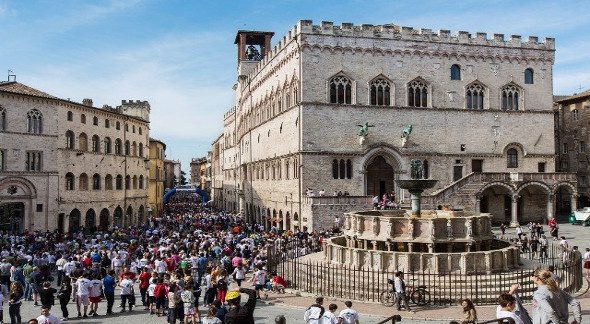
Miniguida alla scoperta di Perugia, capoluogo dell’Umbria
Entrando nella città di Perugia da Porta San Pietro, rifatta all’esterno da Agostino di Duccio nel 1475, s’incontra a destra la Basilica di San Domenico. Nei chiostri e nel convento attiguo è stato ordinato l’importantissimo Museo Archeologico Nazionale dell’Umbria.
Si raggiunge poi la Piazza del Sopramuro, dove si allineano il palazzo quattrocentesco dell’Università Vecchia, unito al Palazzo del Capitano del Popolo. Proseguendo, dopo una breve salita, si apre una delle importanti piazze d’Italia: la Piazza Grande di Perugia (Piazza IV Novembre), dominata al centro dalla Fontana Maggiore risalente al ‘200.
Nella piazza, si apre il superbo complesso monumentale che oltre alla fontana, comprende anche la Cattedrale e lo splendido Palazzo dei Priori.
All’estremo opposto di Corso Vannucci si trova un famoso giardino-belvedere che è stato creato sopra il basamento della Rocca Paolina, ossia la fortezza fatta erigere da Papa Paolo III nel 1540. Questo basamento racchiude, come sotto un’enorme campana, un intero quartiere della città vecchia, una città morta, una specie di Pompei Medievale che è stata rimessa in luce e di cui la visita è oltremodo affascinante.
Le salite e le gradinate di Perugia sono di norma ripide, sia quelle che risalgono alle età più remote sia quelle tracciate in epoche più recenti.
Ad esempio la rampa di Via delle Prome, partendo dall’Arco d’Augusto, conduce al punto più alto della città, dove sorgeva la fortezza di Porta Sole eretta nel secolo XIV dal Gattapone e in seguito distrutta a furore di popolo. Anche la più fugace visita a questo centro d’arte di storia e di cultura non deve trascurare il complesso di San Francesco, e l’Oratorio di San Bernardino: capolavoro d’Agostino di Duccio, che, ricoprendone la facciata di bassorilievi di incantevole grazia e finezza di modellato, ne fece un piccolo poema della scultura rinascimentale.
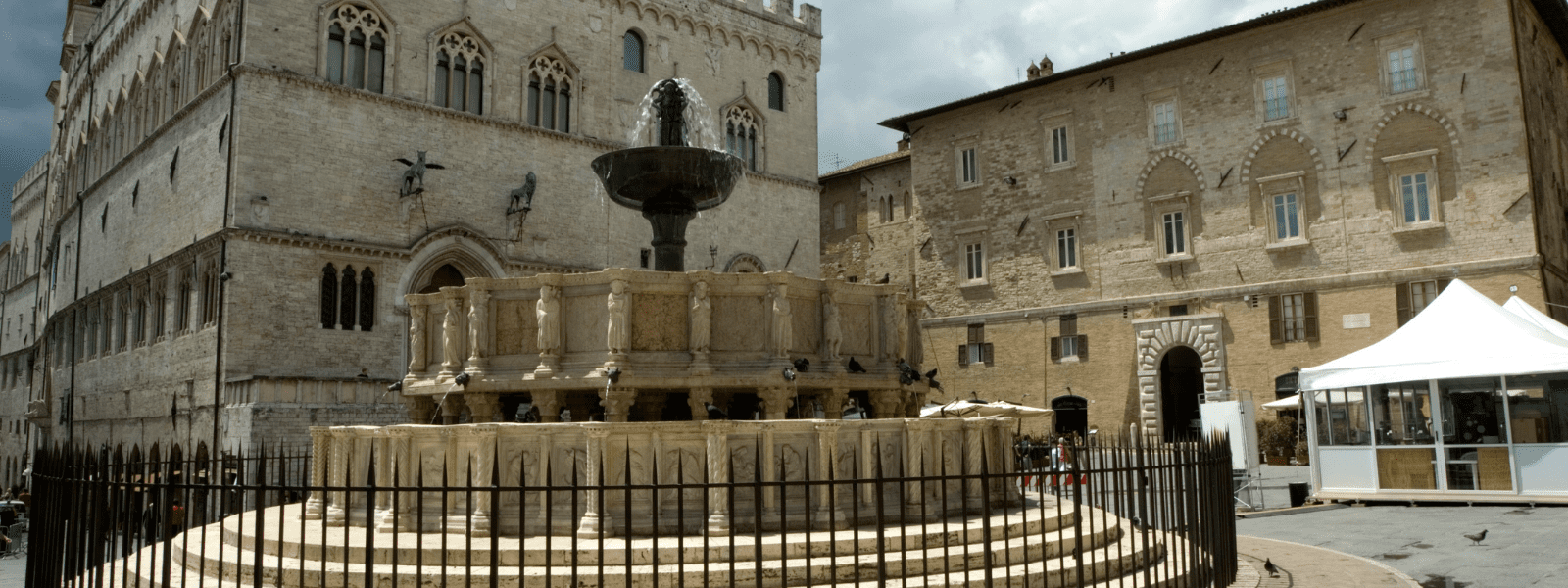
>> Ci sono offerte in scadenza per agriturismi nella zone di Perugia! Clicca e consultale subito
Fra le più importanti manifestazioni che sono organizzate nella città merita senza dubbio una nota particolare il festival musicale di Umbria Jazz, che richiama ogni anno importanti nomi del panorama musicale nazionale e internazionale.
Inoltre, celeberrima è la manifestazione gastronomica di Eurochocolate che si tiene in ottobre, interamente dedicata all’universo del cacao e del cioccolato.
Da ricordare infine a Perugia, luogo principe soprattutto per i bambini, è Città della Domenica, primo parco divertimenti d’Italia!
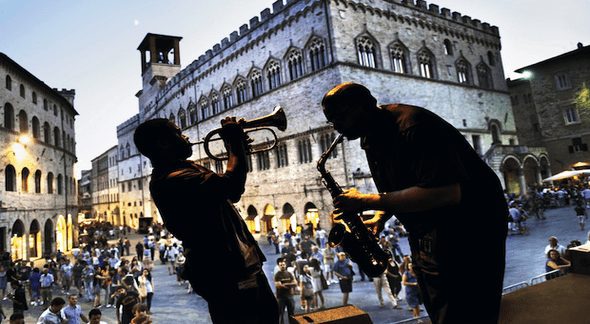
>> Se hai deciso di visitare Perugia ti consigliamo di contattare ora gli hotel nelle sue vicinanze >> clicca questo link
Itinerari a Perugia
Perugia è una città ricca di arte, di storia e di fascino, tutta da scoprire. Ecco una serie di miniguide per godere al meglio delle bellezze della città:
L’area circostante la città di Perugia è ricca di borghi storici e numerose altri tesori capaci di lasciare senza fiato! Dalle perle di Corciano e Deruta, la patria delle ceramiche, agli itinerari attraverso le meraviglie del territorio, Segui i nostri migliori consigli:
Una vacanza nella natura a Perugia
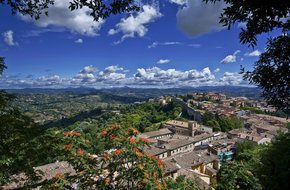
Dall’alto della collina dalla quale sovrasta le terre umbre che la circondano, Perugia regala una vista e dei panorami mozzafiato. E’ possibile trascorrere delle vacanze a stretto contatto con la natura in uno degli agriturismi disseminati nelle campagne circostanti. Attività all’aria aperta, aria fresca e pulita, boschi e prati verdeggianti, la flora più variopinta e una fauna abbondante… questo e altro ti aspettano nel territorio naturale del perugino. Consulta i nostri agriturismi, troverai delle ottime location dove soggiornare in mezzo alla natura e tante offerte speciali:
Una vacanza di relax a Perugia

Se hai in programma di esplorare l’Umbria ed anche di dedicare le tue vacanze al relax e al benessere, Perugia è la città ideale per combinare queste esigenze. Numerose strutture offrono centri benessere, spa e piscine dove regalarsi momenti preziosi di rilassamento. In questi luoghi tranquilli e suggestivi, la bellezza incontaminata della natura umbra si accompagna ad una vasta gamma di offerte pensate appositamente per coccolarti e farti ritrovare l’armonia del corpo e della mente. Ecco la nostra selezione di hotel e agriturismi con servizi SPA e benessere a Perugia:
Una vacanza romantica a Perugia
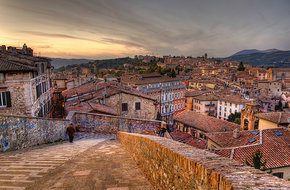
Perugia regala degli scorci e delle prospettive uniche e particolarmente romantiche. La città è l’ideale per una fuga romantica con il proprio partner, e sono presenti delle strutture perfette per regalarsi dei momenti speciali a due. Abbiamo selezionato per te gli hotel e resort di Perugia che offrono location e trattamenti migliori per la tua vacanza romantica:
Mangiare a Perugia
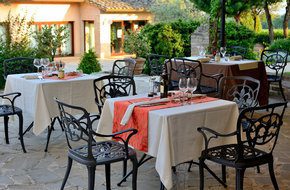
L’offerta gastronomica di Perugia è ricca e variegata, con tanti piatti e proposte della cucina umbra più tipica e genuina. Ingredienti sempre freschi, ricette genuine e tradizionali, elaborazioni raffiante e curate con gusto… questi elementi fanno del mangiare a Perugia una vera e propria esperienza gastronomica da non perdere. Abbiamo predisposto per te una lista di ristoranti di Perugia e strutture come Agriturismi con ristornate, dove poter godere della migliore cucina di Perugia:
>> Scopri tutti gli hotel e agriturismi di Perugia e dintorni, una vacanza speciale ti attende in Umbria!
Buona vacanza a Perugia da noi di Bellaumbria!
“},{“lang”:”en”,”content”:”
Perugia, the great “Guelf strong-hold” rises up in the region’s heart, with its 5 storical quarters closed-in by its Etruscan town walls. These enormous bastions formed by cyclopic square masses, were constructed 22 centuries ago and are still visible for long stretches.
When the city of Rome was little more that an encampment of huts, one could already enter the etruscan Perugia Italy using one of 7 portals, among which one was particularly mighty, the Porta Pulchra or of Augustus, dating back to Etruscan times. Entering the city via Porta San Pietro, whose exterior was remodelled by Agostino di Duccio in 1475, you’ll arrive at the basilica of St. Dominic on the right-hand side; the very important National Archeological Museum of Umbria is to be found in the adjacent cloisters and convent.
Continuing along, you’ll reach the Piazza del Sopramuro, where the 15th century Palace of the Old University and the adjacent Palace of the People’s Captain look down on the square. Further on, after a short climb, you’ll find yourself in one of Italy’s most important squares, where you’ll see the Priors’ Palace, the Cathedral and the 13th century fountain Major Fountain at the center. These monuments render the Piazza Grande of Perugia (now called Piazza IV Novembre) a superb architectural complex. At the extreme end of Corso Vannucci you’ll find famous panoramic gardens built on the foundations of the Rocca Paolina, a strong-hold built by Pope Paul III in 1540. These foundations cont
ain, similar to under an enormous bell, an entire quarter of the old Perugia: a dead city, a sort of Medieval Pompei which has been brought tot light again and which is fascinating to visit. Perugia’s ascents and stairways are usually quite steep, both the most ancient and the most recent. The way Via delle Prome is a typical example. Leaving from the Augustus Arc, this way lead to the upper point of Perugia, where used to be the castle of Porta Sole, erected in the XIV century by the dal Gattapone, and destroyed later for willing of the whole town people. A short visit in Perugia is definetly interesting, but is a longer visit which will reveal all the atistic jewels in detail. Even if you are on a short visit, you should not miss the archtectural complex of St. Francesco, with the Oratory of St. Bernardino, a masterpiece of Agostino di Duccio, who, in covering the facade with bas-reliefs of enchanting grace and modelled fineness made it a little poem of Renaissance sculpture.
Among the most important manifestations taking place in the city we should absolutely mention the musical festival Umbria Jazz and the gastronomic festival Eurochocolate.
To Remember, too, in Perugia, especially for children is the Città della Domenica, first amusement park of Italy!
“},{“lang”:”es”,”content”:”
Perugia, the great “Guelf strong-hold” rises up in the region’s heart, with its 5 storical quarters closed-in by its Etruscan town walls. These enormous bastions formed by cyclopic square masses, were constructed 22 centuries ago and are still visible for long stretches.
When the city of Rome was little more that an encampment of huts, one could already enter the etruscan Perugia Italy using one of 7 portals, among which one was particularly mighty, the Porta Pulchra or of Augustus, dating back to Etruscan times. Entering the city via Porta San Pietro, whose exterior was remodelled by Agostino di Duccio in 1475, you’ll arrive at the basilica of St. Dominic on the right-hand side; the very important National Archeological Museum of Umbria is to be found in the adjacent cloisters and convent.
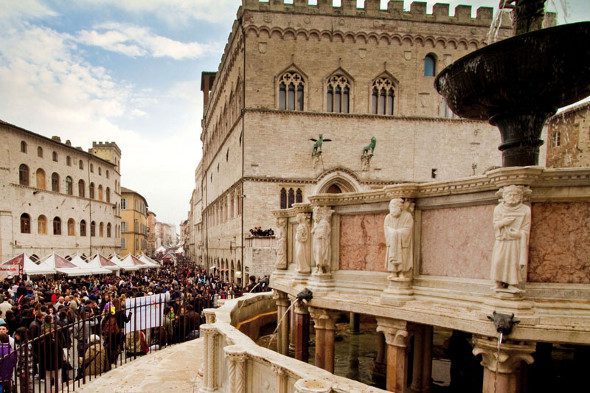
Continuing along, you’ll reach the Piazza del Sopramuro, where the 15th century Palace of the Old University and the adjacent Palace of the People’s Captain look down on the square. Further on, after a short climb, you’ll find yourself in one of Italy’s most important squares, where you’ll see the Priors’ Palace, the Cathedral and the 13th century fountain Major Fountain at the center. These monuments render the Piazza Grande of Perugia (now called Piazza IV Novembre) a superb architectural complex. At the extreme end of Corso Vannucci you’ll find famous panoramic gardens built on the foundations of the Rocca Paolina, a strong-hold built by Pope Paul III in 1540. These foundations contain, similar to under an enormous bell, an entire quarter of the old Perugia: a dead city, a sort of Medieval Pompei which has been brought tot light again and which is fascinating to visit. Perugia’s ascents and stairways are usually quite steep, both the most ancient and the most recent. The way Via delle Prome is a typical example. Leaving from the Augustus Arc, this way lead to the upper point of Perugia, where used to be the castle of Porta Sole, erected in the XIV century by the dal Gattapone, and destroyed later for willing of the whole town people. A short visit in Perugia is definetly interesting, but is a longer visit which will reveal all the atistic jewels in detail. Even if you are on a short visit, you should not miss the archtectural complex of St. Francesco, with the Oratory of St. Bernardino, a masterpiece of Agostino di Duccio, who, in covering the facade with bas-reliefs of enchanting grace and modelled fineness made it a little poem of Renaissance sculpture.
Among the most important manifestations taking place in the city we should absolutely mention the musical festival Umbria Jazz and the gastronomic festival Eurochocolate.
To Remember, too, in Perugia, especially for children is the Città della Domenica, first amusement park of Italy!
“},{“lang”:”de”,”content”:”
Perugia, the great “Guelf strong-hold” rises up in the region’s heart, with its 5 storical quarters closed-in by its Etruscan town walls. These enormous bastions formed by cyclopic square masses, were constructed 22 centuries ago and are still visible for long stretches.
When the city of Rome was little more that an encampment of huts, one could already enter the etruscan Perugia Italy using one of 7 portals, among which one was particularly mighty, the Porta Pulchra or of Augustus, dating back to Etruscan times. Entering the city via Porta San Pietro, whose exterior was remodelled by Agostino di Duccio in 1475, you’ll arrive at the basilica of St. Dominic on the right-hand side; the very important National Archeological Museum of Umbria is to be found in the adjacent cloisters and convent.
Continuing along, you’ll reach the Piazza del Sopramuro, where the 15th century Palace of the Old University and the adjacent Palace of the People’s Captain look down on the square. Further on, after a short climb, you’ll find yourself in one of Italy’s most important squares, where you’ll see the Priors’ Palace, the Cathedral and the 13th century fountain Major Fountain at the center. These monuments render the Piazza Grande of Perugia (now called Piazza IV Novembre) a superb architectural complex. At the extreme end of Corso Vannucci you’ll find famous panoramic gardens built on the foundations of the Rocca Paolina, a strong-hold built by Pope Paul III in 1540. These foundations contain, similar to under an enormous bell, an entire quarter of the old Perugia: a dead city, a sort of Medieval Pompei which has been brought tot light again and which is fascinating to visit. Perugia’s ascents and stairways are usually quite steep, both the most ancient and the most recent. The way Via delle Prome is a typical example. Le
aving from the Augustus Arc, this way lead to the upper point of Perugia, where used to be the castle of Porta Sole, erected in the XIV century by the dal Gattapone, and destroyed later for willing of the whole town people. A short visit in Perugia is definetly interesting, but is a longer visit which will reveal all the atistic jewels in detail. Even if you are on a short visit, you should not miss the archtectural complex of St. Francesco, with the Oratory of St. Bernardino, a masterpiece of Agostino di Duccio, who, in covering the facade with bas-reliefs of enchanting grace and modelled fineness made it a little poem of Renaissance sculpture.
Among the most important manifestations taking place in the city we should absolutely mention the musical festival Umbria Jazz and the gastronomic festival Eurochocolate.
To Remember, too, in Perugia, especially for children is the Città della Domenica, first amusement park of Italy!
“},{“lang”:”fr”,”content”:”
Pérouse, la grande « Arce Guelfa » se dresse au centre de la région avec 5 quartiers historiques renfermés au sein de ses murs Étrusques: un énorme bastion formé de blocs cyclopéens, carrés qui ont été mis en oeuvre 22 siècles auparavant qui sont encore en grande partie visible.
Lorsque la ville de Rome n’était encore qu’un campement de cabanes, la Pérouse étrusque possédait déjà 7 portes, parmi lesquelles celle particulièrement imposante qu’est la porte Pulchra (ou d’Auguste). En entrant par la porte Saint Pierre, refaite extérieurement par Agostino di Duccio en 1475, on rencontre la basilique de Saint Domenico; qui accueille dans ses cloîtres et dans son couvent annexe le très important Musée Archéologique National de l’Ombrie.
>> Vous voulez visiter Pérouse? Consulte maintenant les meilleures hôtels à proximité de Pérouse.
On atteint ensuite la Piazza del Sopramuro, où s’aligne le palais de la Vieille Université (XVème siècle), relié au « Palazzo del Capitano del Popolo ». Après une brève montée, s’ouvre l’une des plus importantes place d’Italie: la Grande Place de Pérouse (Place du IV Novembre), un superbe ensemble monumental qui comprend le Palazzo dei Priori, la Cathédrale, et au centre la Fontaine Majeure du XIIIème siècle.
Du côté opposé de « Corso Vannucci » se trouve un fameux jardin belvédère qui a été créé sur les fondations de la Rocca Paolina : la forteresse faite construire par le Pape Paul III en 1540. Cette fondation renferme, comme sous une énorme cloche, un quartier entier de la vieille ville, une ville morte, une espèce de Pompéi Médiévale qui a été remise en lumière et dont la visite est plus que fascinante.
Les montées et les escaliers sont normalement raides, qu’ils datent d’époques plus anciennes ou plus récentes. On peut citer par exemple, la rampe de « Via delle Prome », en partant de l’Arc d’Auguste, qui conduit au point le plus haut de la ville, où surgit la forteresse de la Porte Soleil construite au XIVème siècle par Gattapone et détruite ensuite par la fureur du peuple. Une visite même fugace de ce centre d’art d’histoire et de culture ne doit pas laisser de côté le complexe de Saint François et l’Oratoire de Saint Bernardin: chef d’�”uvre d’Agostino di Duccio qui, en recouvrant la façade de bas-reliefs d’une grande grâce et d’une grande finesse, en a fait un petit poème de sculpture de la Renaissance.
Parmi les plus importantes manifestations qui sont organisées dans la ville il convient de souligner le festival musical Umbria Jazz et la manifestation gastronomique Eurochocolate.
N’oubliez pas de faire un détour à Pérouse pour vos enfants, vous y trouverez la Città della Domenica, le premier parc d’attractions d’Italie!
“}]}
